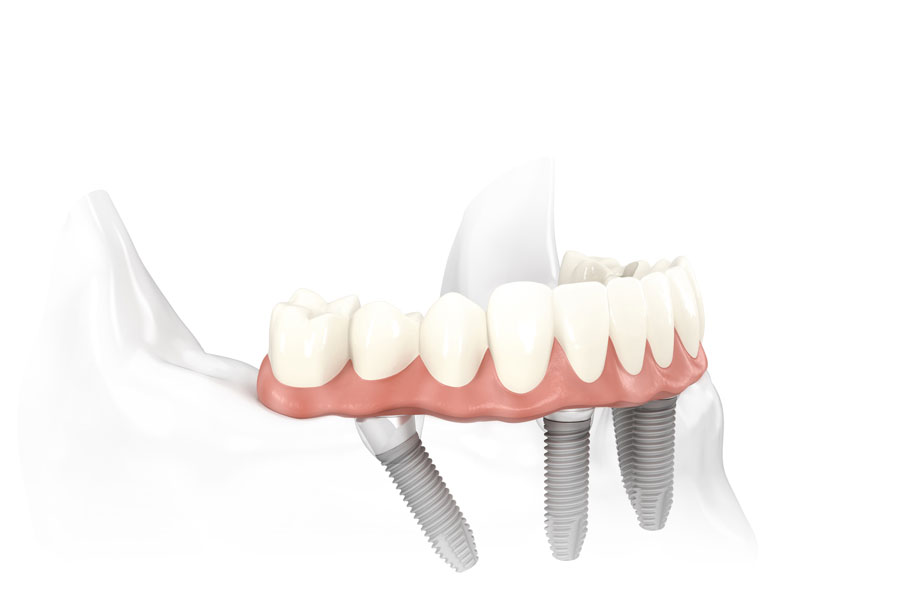If you can’t bite properly into an apple or tears well up in your eyes every time you get close to a steak house, or look at your family photos and you are the only person not smiling, then chances are you have been looking online for a solution to fix your teeth. Chances are you have come across a term called All-on-4. What is All-on-4?
In the initial days of implant dentistry, surgeons placed as many implants as they could in patient jaws in the hopes that the bone would grow around all of them. They over-engineered the bridges to make sure they never failed. Think of it like having the Golden Gate bridge with 10 abutments. Their logic was that less load was applied to each implant and therefore the likelihood of failure was reduced. There are many dentists and surgeons that still have that belief. Those that believe in this philosophy are faced with a patient reality and that is: “patients usually do not have enough bone to insert the 6-8 traditionally placed implants”. These practitioners are then forced to offer their patients bone grafting procedures such as sinus lifting (moving the sinuses up to make room for bone), Horizontal and vertical ridge augmentation (adding bone volume to the existing patient bone to allow for implants. These surgeries increase treatment time, could have serious complications, and increase the cost of treatment.
Figure 1: A traditional bridge supported by 5 implants
Several years back, a pretty smart dentist (Dr. Paulo Malo) discovered that if the posterior implants were tilted, implants could be placed in patient’s bones without the need for extra bone augmentation procedures and would avoid vital structures such as the sinuses and nerves. This technique was termed All-on-4 because the final bridge was placed on 4 implants. The more traditional dentists make fun of this technique by highlighting its Achilles heel; they say: “All-on-4 none on three”. What this means is that if one of your implants fails, then you are out of luck. This is not really true, try telling these detractors that clowns still get around in a tri-cycle and they will be pretty upset. Proponents of this technique have been pointing at hundreds of thousands of these procedures performed and 10 year studies on them showing 95% success rate. Other implant companies have come up with trendy names for this concept like “Teeth Xpress”, “Uni-For-Fixed”, “teeth in a day”, “teeth in an hour”, “Pro-Arch”.
Figure 2: A bridge supported by 4 implants in All-on-4 configuration.
Note the tilted implant is designed to avoid a major nerve but still be in ample bone.
We at Implant Genius believe that treatment should be patient specific. There are many patients that could benefit from All-on-4 treatment due to a reduced need for extra surgeries and lower cost. However, there are individuals that may require over-engineering of their bridge. For example in patients who heavily grind their teeth or have a higher chance of implant failure due to a health issue.
No matter which treatment your dentist chooses for you, these multiple implant treatment modalities are the most challenging treatments that a dentist or surgeon can perform. If planning for one implant can be compared to a hike up a local mountain, a 4-8-implant treatment planning situation is like climbing mount Everest. The clinician must pay close attention to how you smile, how much gum you show, what material the final bridge is going to be made out of, what your bite is going to be like, and how you are going to clean your teeth.
What we often get asked is how much does the procedure cost? The answer to that is very complicated and it depends on how many implants you require. It also depends on what material your final bridge is going to be made out of. If the final bridge is going to be made out of acrylic teeth (think denture teeth) embedded in pink acrylic wrapped around a titanium bar, that is going to be cheaper than a much harder, more stain resistant material called zirconia. The Zirconia bridge does not wear away as rapidly and therefore has much lower maintenance than an acrylic denture. I find it interesting that patients do not pay attention to the material the bridges are made out of. It is like you walking into a car dealership but not caring to see if the brand new car you are going to buy has an engine!
We at Implant Genius are uniquely positioned for this type of planning. We are Prosthodontists! Like Architects responsible for planning and drawing up blueprints for a house, we plan and design restoration of multiple missing teeth for the mouth.
Let’s start planning your new smile!

